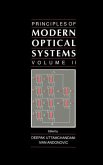Optical communication refers to any type of communication that uses light to carry information. An optical communication system is composed of three major components, which include a transmitter, channel and receiver. Transmitter is used to encode a message into an optical signal. Semiconductor devices such as light-emitting diodes (LEDs) and laser diodes are the most commonly used transmitters. The function of a channel is to carry the signal to its destination. Receiver is a component that reproduces the message from the received optical signal. Modern communication relies on optical networking systems which use optical fiber, optical amplifiers, lasers, switches, and routers. The most common type of channel used for optical communications is the optical fiber. The light in an optical fiber is guided by the principle of total internal reflection. The main advantages of optical communication include high bandwidth, exceptionally low loss, large transmission range, and no electromagnetic interference. This book includes some of the vital pieces of work being conducted across the world on various topics related to optical communications. It will serve as a valuable source of reference for graduate and postgraduate students.
Hinweis: Dieser Artikel kann nur an eine deutsche Lieferadresse ausgeliefert werden.
Hinweis: Dieser Artikel kann nur an eine deutsche Lieferadresse ausgeliefert werden.








